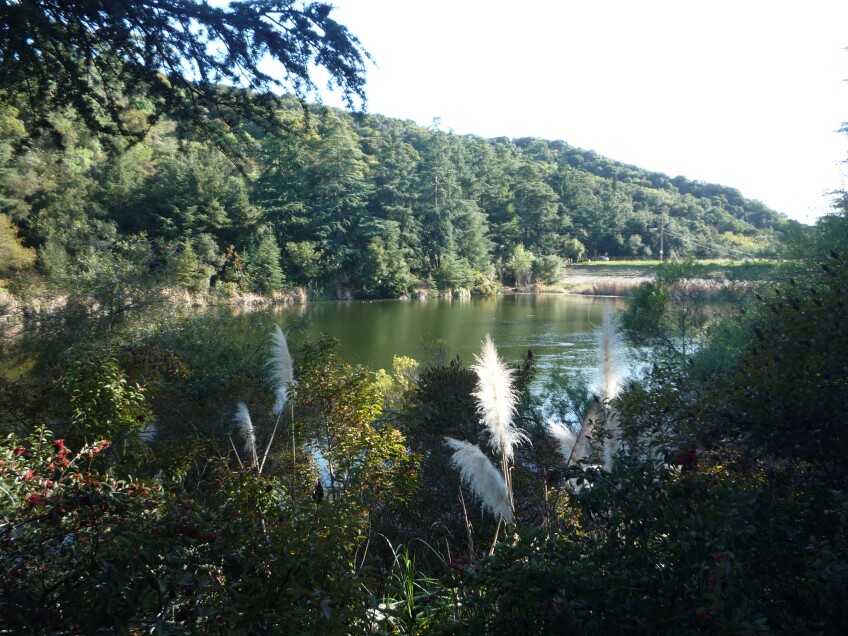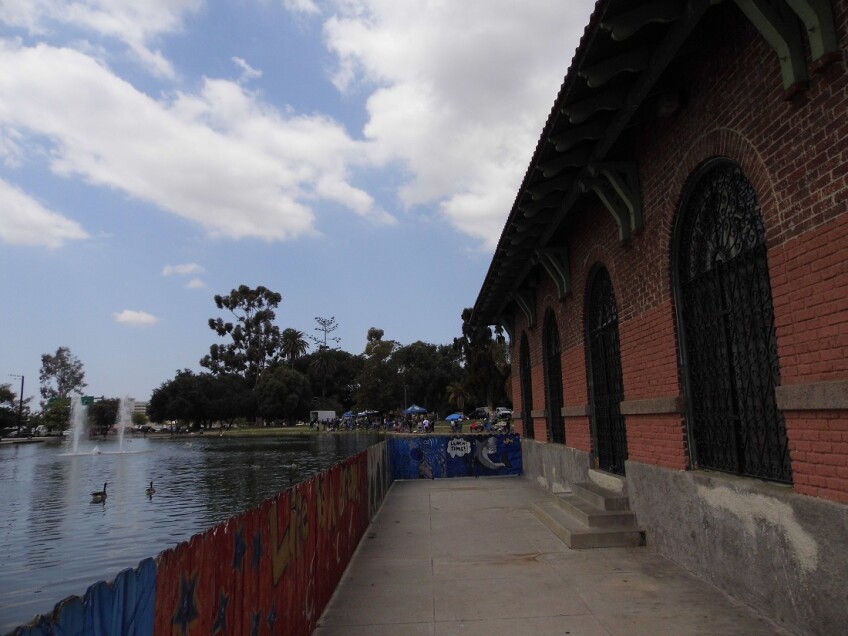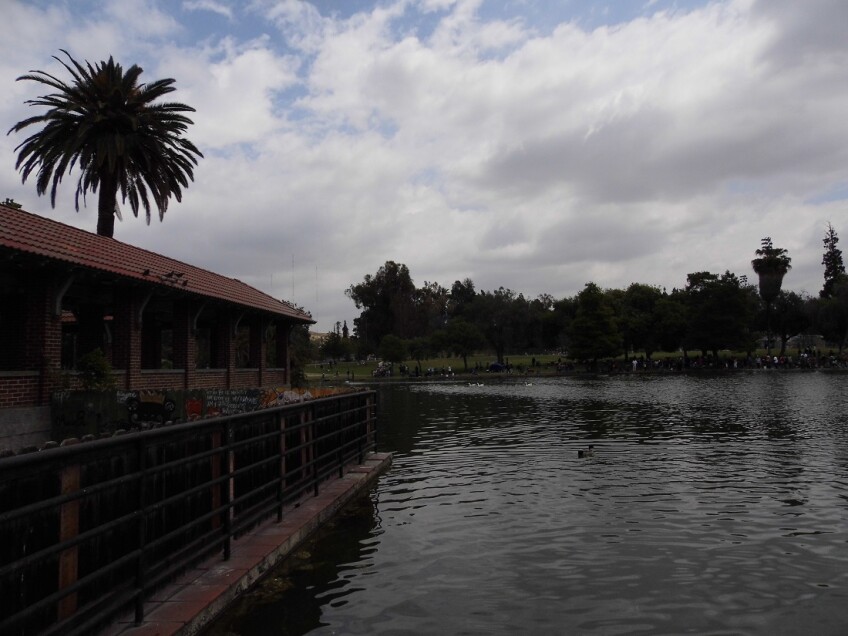Six Great LA “Lakes”

Natural lakes are a rarity in California – especially Southern California.
Generally, you’d have to go as far north as, say, Lake Tahoe or Lee Vining to find Mono Lake, Convict Lake, and other naturally-formed bodies of water.
LA has already drained pretty much all the water from Owens Lake.
So that means many of the “lakes” that are accessible to Angelenos are actually reservoirs – Castaic Lake, Pyramid Lake, Lake Hollywood, and so on.
And other lakes – like Lake Elsinore, Lake Elizabeth, and Lake Hughes – are technically sag ponds. Yes, they’re natural bodies of water, but they’re not fed by any external source, like a river. Instead, they’re areas where the movement of a seismic fault (like the San Andreas) created a gap and the groundwater rose up to fill the space.
Somehow that doesn’t seem to count.
Considering LA is a metropolitan area with so many neighborhoods and unincorporated communities named after lakes – Silver Lake, Westlake, Westlake Village, Lakeview Terrace, and the like – it makes you wonder where the actual LAKES of LA are?
Toluca Lake has one, but it’s privately owned and inaccessible to the public.
Well, maybe it doesn’t matter if a lake in LA is “real” or not. After all, we live in an area surrounded by movie magic. If there’s any place we want to go, we don’t have to leave LA – we can just build the place right here.
So whether it’s fishing, boating, birding, picnicking, or just experiencing the novelty of actually seeing a body of water – even in the summertime – here are six great bodies of water we call “lakes” of greater LA.
Baldwin Lake, The Arboretum, Arcadia
You’ll find the natural body of water named after the infamous “Lucky” Baldwin on the grounds of the Los Angeles County Arboretum & Botanic Garden, surrounded by the Queen Anne Cottage from Baldwin’s Santa Anita Ranch and the Hugo Reid Adobe from 1840, which was named after the first private owner of the Rancho Santa Anita. These days, in the drought, the lake is more like a lagoon – its water levels having diminished and some of its mud banks exposed. But it’s still got fish (the common carp), although the infamous frogs (and signs of other amphibian life) are long gone.


Lake Balboa, Van Nuys
When you go boating or fishing at Lake Balboa, you may not know it, but you’re making good use of water that would otherwise go to waste. You may want to put down your fork before reading about the source of Lake Balboa’s water. Ready? It’s the nearby Donald C. Tillman Water Reclamation Plant, which processes some (but not all) of LA's wastewater (i.e. toilet water) that gets pumped in from the sewers. But this water is probably cleaner than any natural source of water (including the LA River, which has recently been harboring high levels of fecal bacteria) because of the rigorous and thorough cleaning and disinfecting process it goes through at the plant. Solids (including poop) are removed, and then the de-pooped water is filtered, chlorinated and dechlorinated. And if there’s any doubt as to the health or safety of that reclaimed water, just look at the cherry blossom trees around the lake in the springtime – or at the Japanese garden (a.k.a. the “garden of water and fragrance") that’s also irrigated by it, right next door to the plant.


Lake Shrine, Pacific Palisades
Tucked away in the Pacific Palisades is a little hideaway called Lake Shrine, where silent movies were once filmed in the 1920s. Once known as Lake Santa Ynez, it was actually formed when a developer moved earth for grading without filling it back in before natural springs filled it with water. In fact, Lake Shrine is known as the only natural spring-fed lake within LA city limits – though now, it’s less for recreation and more for meditation. After a vivid dream, the developer sold the property – including a windmill, a houseboat, and a mill house – to the Self-Realization Fellowship Church of All Religions in the 1940s, which still holds ceremonies, retreats, and other events there today. It's a quiet, cell phone-free zone where you might find a cat sprawled on the sidewalk in the sun, turtles in the water, and inspirational passages from different sacred texts. If nothing else, it’s a lovely hidden garden and a cool escape from the heat.

Franklin Canyon Park, Beverly Hills
Tucked inside the chaparral, grassland, and oak woodland habitat of Franklin Canyon Park in Beverly Hills, there’s a three-acre lake that served as the fishin' hole in the opening credits of The Andy Griffith Show and the lagoon in Creature from the Black Lagoon. But contrary to what you might’ve seen in film or television, there’s no swimming or fishing permitted here – and the only creatures you may find are the frogs that sing a chorus as night begins to fall. Franklin Canyon is a great place for night hiking, with regularly-scheduled full moon hikes accompanied by a naturalist. But if you really want to see something – and your hike has been cut short by the development of the private section of the Hastain Trail – visit the lake during the day, where you’re sure to see both local and visiting birds traveling along the Pacific Flyway.


Lincoln Park Lake, Lincoln Heights
There’s a surprising amount of year-round fishing you can do at Lincoln Park Lake, just northeast of Downtown Los Angeles. The former Eastlake Park (the eastern counterpart to Westlake) is one of LA’s oldest public parks, officially dedicated in 1883. It’s regularly supplied with rainbow trout, catfish, carp, and more. The surrounding park has picnic areas, BBQ pits, a lighted baseball diamond, a skatepark, and the nearby Plaza de la Raza cultural center – whose formation saved the park’s historic boat house from demolition. The lakeside landmark is now used as an art gallery, with a rotating calendar of exhibits.


Debs Lake, Ernest E. Debs Regional Park, Northeast LA
One of the best payoffs to a Southern California hike is water – but while many of our waterfalls are running dry in the summer months (and several years into a drought), you can still hike five miles around Debs Park in NELA and find yourself taking a rest on a lakeside bench, surrounded by ducks and turtles. In the park, palms coexist with evergreen and deciduous trees, and wildflowers jump out in intermittent bursts of color as you walk along. Don’t dare take a dip in the “lake” (which is more of a pond), and there’s no fishing permitted (although there are bass, bluegill, and bullhead in there) – but you’ll get a great view of the city below as you take a rest. Bring your binoculars and cameras for the diverse species of birds that you’ll find there. The Audubon Center at Debs Park can brief you on which Pacific Flyway birds there are to see at any given time.







